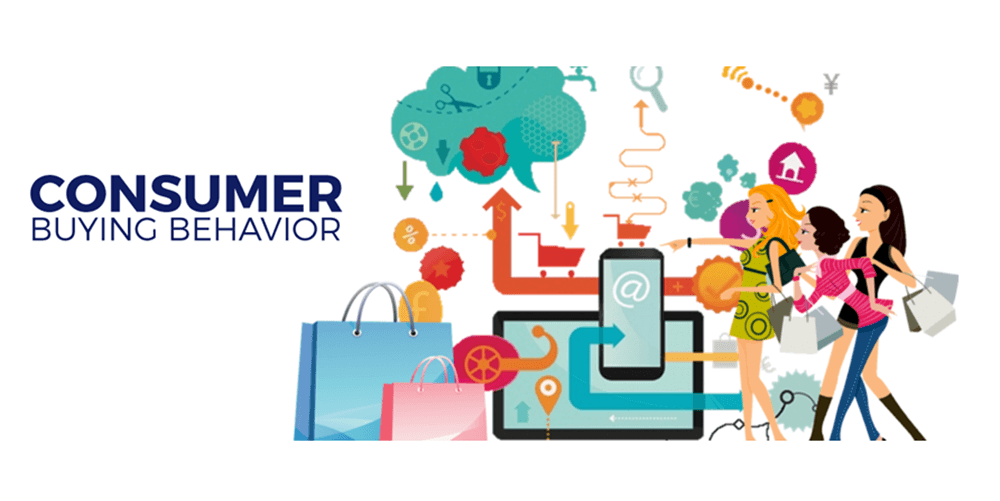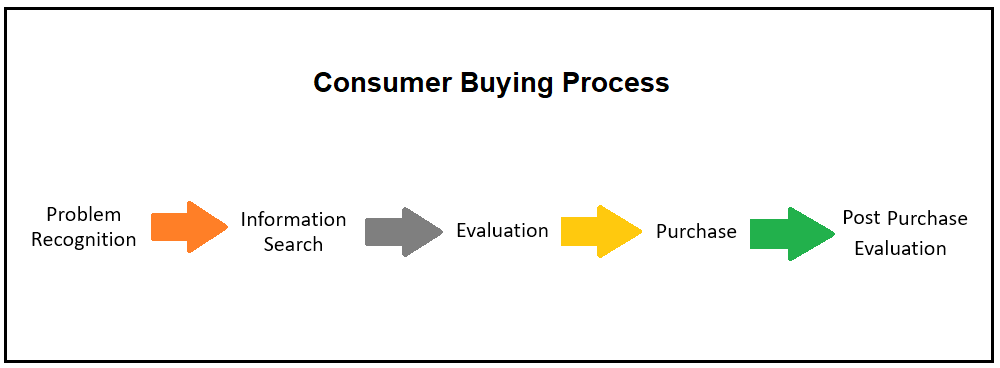
Consumer behaviour refers to the physiological process related to the emotions of the consumer. For Marketers, it is important to understand Consumer behaviour as it provides them with a better understanding of the buying pattern of consumers. Consumer behaviour is a key aspect of marketing and there is a considerable body of literature on the subject.
Think about the last product you purchased. How did you decide what brand to buy? Did you consider lots of brands? Do you always buy a certain brand? Do you buy the same brands as your family have always purchased? Did you purchase because of a special offer?
The buyer behaviour of consumers is a complex process and we will examine models and influences that aim to help us to better understand it.
Customers v/s Consumers
Anyone who regularly makes purchases from a store or a company is termed as ‘customer’ of that store or that company.
A ‘consumer’ is anyone who engages in any one or all the activities mentioned in the definition
A consumer is someone who pays money to buy a product or service from an organization; without consumers there would be no motivation for businesses to produce products/services.
What is consumer behaviour?
Consumer behaviour is the study of how individuals or groups buy, use and dispose of goods, services, ideas or experiences to satisfy their needs and wants.
It is the behaviour that consumers display in searching for, purchasing, using, evaluating and disposing of products and services that they expect will satisfy their needs.
In its simplest terms consumer behaviour includes the study of:
- What they buy?
- Why they buy it? (often the most difficult question to answer)
- When they buy it?
- Where they buy it?
- How often they buy it?
- How often they use it?
- How they evaluate it
Solomon (2020, p.22) states: “It is the study of the processes involved when individuals or groups select, purchase, use, or dispose of products, services, ideas or experiences to satisfy needs or desires”.
Kotler et al (2017, p.139) define consumer buyer behaviour as: “The buying behaviour of final consumers – individuals and households that buy goods and services for personal consumption”.
Useful Read:
How supermarkets get you to spend more money
Consumer behaviour applications in marketing
Analysing market opportunity such as Identifying unsatisfied needs and wants (e.g. – childcare centre, gadgets, etc.)
Selecting target market such as Identifying distinct consumer segment, designing products to satisfy their needs (e.g. – shampoo and oil in sachets)
Marketing Mix decisions:
- Product – size, shape, features, packaging
- Price – high, same or low price v/s competition, discounts.
- Promotion – advertising, sales promotion, direct marketing, public relations, personal selling, interactive services.
- Place – existing retail outlets or exclusive outlets or only direct selling

Role Theory
One of the theories cited by Solomon (2020) is role theory which “takes the view that much of consumer behaviour resembles actions in a play. We as consumers seek the lines, props, and costumes necessary to put on a good performance” and “That’s why it’s important for marketers to provide each of us ‘actors’ with the props we need to play all of our varied roles: these might include ‘up and coming executive’, ‘geek’ or ‘hipster’ (Solomon, 2020, p.32).
What influences consumer behaviour?
“Consumer behaviour is affected by a broad range of demographic factors as well as our individual experiences, motivations, beliefs and attitudes which impact the way we react to organisations’ marketing activities” (CIM, 2010, p.55)
There are several factors that can influence our behaviour. Kotler and Armstrong (2008) classify these factors as under:
- Social (reference groups, family, roles and status)
- Cultural (habits, beliefs and principles imbibed from family and community)
- Personal (age and life-cycle stage, occupation, economic circumstances, lifestyle, personality and self concept)
- Psychological (motivation, perception, learning, beliefs and attitudes)
These factors cause consumers to develop product and brand preferences.
- Culture is the fundamental determinant of a person’s wants and behaviours acquired through socialisation processes with family and other key institutions.
- Cultural level – “cultural factors exert the broadest and deepest influence” (Kotler and Keller, 2017, p.179).
- Subcultures, Nationalities, Religions, Racial groups, Geographic regions
Characteristics of social classes:
- Within a class, people tend to behave alike
- Social class conveys perceptions of inferior or superior position
- Class may be indicated by a cluster of variables (occupation, income and wealth)
Social Factors: Reference Groups, Family, Social Roles, Statuses.
Reference groups
- Direct or indirect influence on attitudes and behaviour
- Primary groups: interact continuously and informally – family, friends, neighbours and co workers
- Secondary groups: religious, professional, trade union – more formal and less continuous interaction
- Three ways of influencing: Exposure to new behaviours and lifestyles. Influence attitudes and self-concept. Create pressures for conformity
- Also, aspirational groups and dissociative groups
- Opinion leaders are important to marketeers
Family distinctions affecting buyer decisions:
- Family of orientation – parents and siblings
- Family of procreation – spouse and children. Different products purchased individually / jointly
Children’s influence
- Direct influence – hints, requests and demands
- Indirect influence – awareness of children’s preferences
- Two year’s old – recognition of characters, logos, brands
Roles and status: What degree of status is associated with various occupational roles?
Personal Factors: Age, Values, Life-cycle stage, Occupation, Personality, Self-concept, Wealth
Age and consumer behaviour
- Baby boomers:1946 – 1964
- Generation X: 1965 – 1976
- Generation Y: 1977 – 1994
Consumer Product Acquisition Process
The Consumer Product Acquisition Process follows the following steps:- Motive Development
- Information Gathering
- Proposition Evaluation
- Proposition Selection
- Acquisition/Purchase
- Re-evaluation: After the purchase, consumers may experience dissonance, which may threathen post-purchase satisfaction.
Sources of information: Personal, Commercial, Public, Experiential
Key psychological processes: Motivation, Perception, Learning, Memory
Perceptions and Selective Exposure
Definition of Perception: based on prior attitudes, beliefs, needs, stimulus factors, and situational determinants [i.e. factors specific to the situation], individuals perceive objects, events, or people in the world about them. Perception is the cognitive impression that is formed of ‘reality’ which in turn influences the individual’s actions and behaviour toward that object.
If we paid attention to all the messages we receive, rather than filtering out those we find meaningful, we would probably become overloaded, just like a computer when it crashes. The process of screening meaningful from non-meaningful information is known as selective exposure (Dubois, 2000).
We avoid exposure to certain messages and actively seek out others, e.g. particular newspapers, magazines, internet websites, or terrestrial, cable, satellite, or internet TV.
Perception:
- Perception: Selective attention – screen out most stimuli
- Selective retention –retain info that supports our attitudes and beliefs
- Selective distortion – interpret info in a way that fits our perceptions
- Subliminal perception –embed covert messages
Read: Perceptual maps
Learning and Memory
Classical Conditioning – This approach to learning is frequently used in marketing through the use of:
- jingles in advertising, e.g. Danone’s ‘mmm, Danone’ sonic logo to indicate the lip-smacking ‘goodness’ of its offerings;
- supermarkets include bakery sections to cause consumers to buy more as they associate the smell of warm bread with eating; and
- perfume and aftershave manufacturers (e.g. L’Oréal) place free samples of products in sachets in magazines so that when readers see an advert for a particular brand of perfume/aftershave they associate the image they see with the smell, and so are more likely to purchase the product when they see its image in the future.
Operant Conditioning – is learning through behavioural reinforcement. The behaviour would occur more readily in connection with a particular stimulus if the required resulting behaviour had been reinforced, through punishment or reward. For example, supermarkets reinforce our loyalty by providing reward cards and points for purchasing particular items, e.g. the Nectar card in Britain, a reward card that links a supermarket, selected retailers, and petrol retailers, to a points system.
Social Learning – we could learn not only from how we respond to situations but also from how others respond to situations, known as modelling. In social learning, we learn by observing the behaviour of others. Companies have long recognized the power of peers, particularly in the social media world, encouraging purchasers to leave reviews of products that they have previously bought, ‘like’ their Facebook pages, and retweet their messages.
The Memorization process
Our memories, as a system for storing perceptions, experience, and knowledge, are highly complex (Bettman,1979). A variety of memorization processes can affect consumer choice, including the following:- Factors affecting recognition and recall;
- The importance of context;
- Form of coding and storage in memory;
- Load processing effects;
- Input mode effects;
- Repetition effects.
Theories of Personality
- The psychoanalytic approach which stresses self-reported unconscious desires;
- trait theory which stresses the classification of personality types; and
- the self-concept approach, which is concerned with how we perceive ourselves as consumers.
The Psychoanalytic Approach
First outlined by Sigmund Freud, we are motivated by our unconscious desires and the relationship of three mental systems as follows:
Id: This part of our psyche harbours our instinctual drives and urges, a kind of seething mass of needs, which require instant gratification.
Ego: This part of the psyche attempts to find outlets for the urges in our id and acts as a planning centre to determine the opportunities for gratification of our urges. According to Freud, the ego is moderated by the superego.
Superego: This part of our psyche controls how we motivate ourselves to behave to respond to our instincts and urges, so that we do so in a socially acceptable manner and avoid any feelings of guilt or shame. It acts as a social conscience.
The Trait and Self-Concept Approaches
Trait Approach
This approach to personality categorizes people into different personality types or so-called traits. Researchers characterize personalities according to bipolar scales:
Self-Concept Approach
People buy goods and services for the brand that they represent and its relation to the buyers’ perception of their own self-concept or personality.
- In a study of the luxury goods market, Dubois and Duquesne (1993) demonstrated how buyers of luxury goods typically divided into one of two categories, as follows:
- Those that made their purchases principally on product quality, aesthetic design, and excellence of service, motivated by the desire to impress others, ability to pay high prices, and the ostentatious display of their wealth.
- Those that bought luxury goods for what they symbolize, purchasing luxury goods because they represent an extreme form of the expression of their own values.
Consumer Psychology in a Downturn
Read: Consumer Motivations – Maslow’s Hierarchy of Human Needs
BATheories.com is managed by a group of educators from Mumbai. We also manage the website StudyMumbai.com. Our panel includes experienced professionals and lecturers with a background in management. BATheories is where we talk about the various business theories and models for BA (Business Administration) students.
